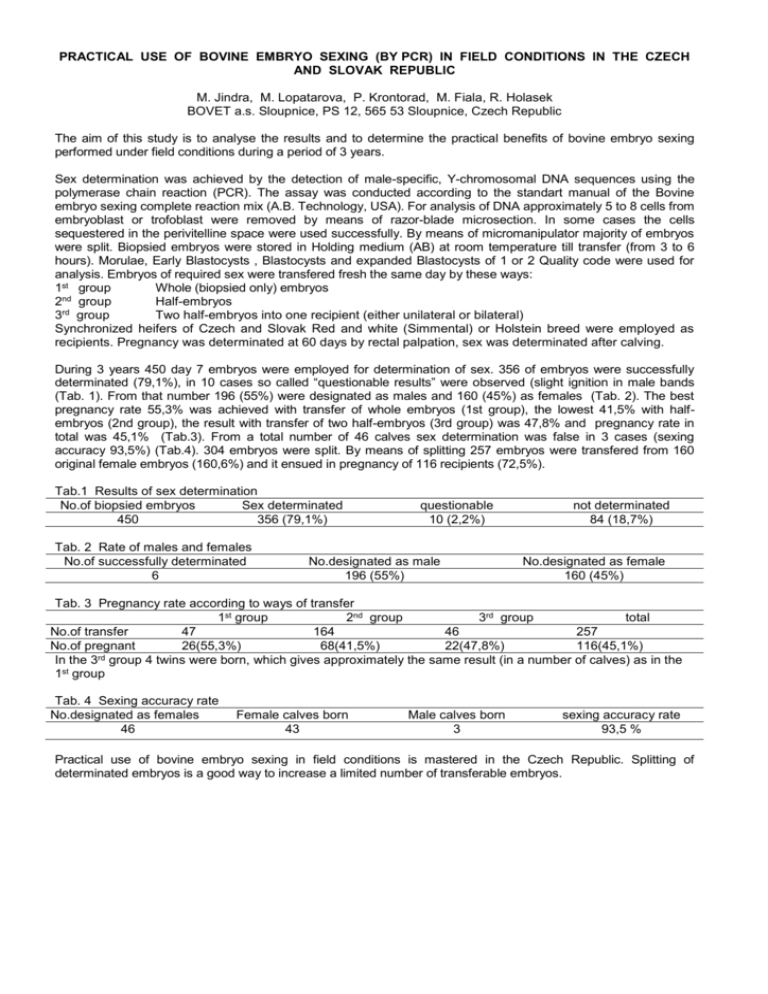practical use of bovine embryo sexing (by pcr) in field conditions in
advertisement

PRACTICAL USE OF BOVINE EMBRYO SEXING (BY PCR) IN FIELD CONDITIONS IN THE CZECH AND SLOVAK REPUBLIC M. Jindra, M. Lopatarova, P. Krontorad, M. Fiala, R. Holasek BOVET a.s. Sloupnice, PS 12, 565 53 Sloupnice, Czech Republic The aim of this study is to analyse the results and to determine the practical benefits of bovine embryo sexing performed under field conditions during a period of 3 years. Sex determination was achieved by the detection of male-specific, Y-chromosomal DNA sequences using the polymerase chain reaction (PCR). The assay was conducted according to the standart manual of the Bovine embryo sexing complete reaction mix (A.B. Technology, USA). For analysis of DNA approximately 5 to 8 cells from embryoblast or trofoblast were removed by means of razor-blade microsection. In some cases the cells sequestered in the perivitelline space were used successfully. By means of micromanipulator majority of embryos were split. Biopsied embryos were stored in Holding medium (AB) at room temperature till transfer (from 3 to 6 hours). Morulae, Early Blastocysts , Blastocysts and expanded Blastocysts of 1 or 2 Quality code were used for analysis. Embryos of required sex were transfered fresh the same day by these ways: 1st group Whole (biopsied only) embryos 2nd group Half-embryos 3rd group Two half-embryos into one recipient (either unilateral or bilateral) Synchronized heifers of Czech and Slovak Red and white (Simmental) or Holstein breed were employed as recipients. Pregnancy was determinated at 60 days by rectal palpation, sex was determinated after calving. During 3 years 450 day 7 embryos were employed for determination of sex. 356 of embryos were successfully determinated (79,1%), in 10 cases so called “questionable results” were observed (slight ignition in male bands (Tab. 1). From that number 196 (55%) were designated as males and 160 (45%) as females (Tab. 2). The best pregnancy rate 55,3% was achieved with transfer of whole embryos (1st group), the lowest 41,5% with halfembryos (2nd group), the result with transfer of two half-embryos (3rd group) was 47,8% and pregnancy rate in total was 45,1% (Tab.3). From a total number of 46 calves sex determination was false in 3 cases (sexing accuracy 93,5%) (Tab.4). 304 embryos were split. By means of splitting 257 embryos were transfered from 160 original female embryos (160,6%) and it ensued in pregnancy of 116 recipients (72,5%). Tab.1 Results of sex determination No.of biopsied embryos Sex determinated 450 356 (79,1%) Tab. 2 Rate of males and females No.of successfully determinated 6 questionable 10 (2,2%) No.designated as male 196 (55%) not determinated 84 (18,7%) No.designated as female 160 (45%) Tab. 3 Pregnancy rate according to ways of transfer 1st group 2nd group 3rd group total No.of transfer 47 164 46 257 No.of pregnant 26(55,3%) 68(41,5%) 22(47,8%) 116(45,1%) In the 3rd group 4 twins were born, which gives approximately the same result (in a number of calves) as in the 1st group Tab. 4 Sexing accuracy rate No.designated as females 46 Female calves born 43 Male calves born 3 sexing accuracy rate 93,5 % Practical use of bovine embryo sexing in field conditions is mastered in the Czech Republic. Splitting of determinated embryos is a good way to increase a limited number of transferable embryos.







